50 I Believe Essay Topics
To better train students on how to present their personal opinions on subjective matters, teachers will assign what is known as an “I Believe” or “This I Believe” essay writing assignment.
Designed to provide the reader with insight into the writer’s character, these essays are typically written in first-person point of view. The writer shares their beliefs on a particular topic – ranging from religion and politics to more personal subjects such as love and happiness – and offers supporting arguments for why they hold these beliefs.

The Challenges of Writing “I Believe” Essays
This type of essay prompt is a welcome break from more detail-oriented or researched-based writing assignments for many students. However, “I believe” essay writing assignments aren’t always easy.
It can be challenging for students to articulate their beliefs in a clear and concise way that isn’t argumentative or offensive to the reader. Students may also struggle to explain their reasoning behind these beliefs in a thorough and not overly simplistic way.
Despite these challenges, “I believe” essays can be an excellent opportunity for students to share their thoughts and feelings on important topics and learn more about themselves in the process.
Tips for Writing “I Believe” Essays
If you’re given an “I believe” essay assignment, here are a few tips to help you get started:
- Start by defining what it is that you believe. This may seem like a simple task, but it can be challenging to identify your core beliefs. If you’re struggling, start by jotting down a list of topics that are important to you – from politics and religion to family and friendship.
- Reflect on why each topic is important to you. Think about the reasoning behind your choices and how these reasons evolved over time. After all, your core beliefs are likely to have changed or grown since you reached adolescence.
- Determine which of your beliefs are the most important. Focusing on developing thought processes that support your beliefs. For extra help, consider sharing these thoughts with a trusted friend or family member for advice.
By reflecting upon your core beliefs and developing clear arguments to support them, you can craft a powerful “I believe” essay that will truly reflect your thoughts and feelings.
How to Write an “I Believe” Essay
To craft a well-written “I Believe” essay, students must forgo the typical essay structure of introduction, body, and conclusion.
Instead, the essay should be organized around a series of specific beliefs that the writer wishes to share. Each thought should be introduced with a clear thesis statement, followed by supporting arguments and examples.
The conclusion of the essay should wrap up the main points that have been made and leave the reader with a final thought to ponder.
Here is an example of how an “I Believe” essay might be structured:
Thesis: I believe that everyone has the right to love and be loved.
Argument: Everyone deserves to find love and experience happiness in their lives. This should not be limited by race, religion, socioeconomic status, or any other factor.
Example: I saw a video of a man proposing to his girlfriend at Fenway Park. She said yes and the crowd went wild! Now that is love. If they can find it, then so can we all!
Conclusion: Society should not stand in the way of love. Love is the most powerful force in the world, and we should all embrace it.
As you can see, the “I Believe” essay structure allows for a great deal of flexibility. Students can choose to focus on a variety of topics and can organize their essays in different ways. An “I Believe” essay can be an excellent opportunity for students to present their thoughts on important issues under a few simple guidelines. With a bit of planning and organization, this type of essay writing assignment can be a breeze!
What You Shouldn’t Do When Writing an “I Believe” Essay
To ensure that you are writing an “I Believe” essay and not another form of an argumentative or persuasive essay, avoid doing the following:
- Don’t provide evidence or use statistics to support your position – this is not an essay that calls for research.
- Don’t attack or criticize the beliefs of others – your goal is to share your own opinions, not to tear down those of others.
- Don’t go off on tangents – stay focused on the main points you want to make.
- Don’t speak objectively or in the third person – for example, don’t say “people believe that” or “studies show.”
- Don’t use filler words and phrases such as “I think,” “I feel,” and “it seems like.”
Use any of these 50 “I Believe” essay topics to help you brainstorm ideas for your essay!
I Believe Essay Topics About Life
- I believe that life is too short to spend time with people who bring you down.
- I believe that laughter is the best medicine
- I believe that we should make time for quiet reflection every day.
- I believe that the only thing that matters in life is love.
- I believe that we are all capable of change.
- I believe that it is never too late to learn and grow.
- I believe in the power of positive thinking.
- I believe that we should always be kind, even when it is difficult.
- I believe that there is no such thing as a coincidence.
- I believe in the saying “what goes around, comes around.”
- I believe that we are all responsible for our own happiness.
- I believe that the best things in life are free.
- I believe that it is essential to be grateful for what we have.
- I believe that it is never too late to achieve our dreams.
- I believe that we should surround ourselves with people who make us better.
- I believe that you can either love or hate something; there is no in-between.
I Believe Essay Topics About Education & School
- I believe that education is the key to a bright future
- I believe that children are our future and should be treasured as such.
- I believe that there is no such thing as a dumb question.
- I believe that schools should do more to celebrate diversity.
- I believe that homework is essential, but it should not be excessive.
- I believe in the importance of having a strong support system while attending school.
- I believe that standardized tests are not an accurate measure of a student’s knowledge.
- I believe that it is vital to find a balance between work and play while in school.
- I believe that everyone should have the opportunity to learn how to swim.
- I believe in the importance of recess and physical activity in students’ lives.
- I believe that there is no such thing as a bad grade.
- I believe that teachers deserve more respect and better pay.
- I believe that it is never too early to learn a foreign language.
- I believe that education should be free for everyone.
I Believe Essay Topics About Friends & Family
- I believe that family is the most important thing in life.
- I believe that friends are the family we choose for ourselves.
- I believe that it is essential to maintain close relationships with friends and family.
- I believe that there is no substitute for quality time spent with loved ones.
- I believe that family is not defined by blood but by love and commitment.
- I believe that we should spend more time with the people we care about and less time worrying about material things.
- I believe that it is better to have a few close friends than many superficial ones.
- I believe that it is healthy for friends to grow apart.
- I believe that competition between friends is healthy.
I Believe Essay Topics About Money
- I believe that money cannot buy happiness.
- I believe that it is essential to be happy with what you have, not what you want.
- I believe that people are more important than things.
- I believe that it is okay to splurge on something even if it means going into debt.
- I believe that it is better to give than to receive.
- I believe that money can’t buy everything.
- I believe that the love of money is the root of all evil.
- I believe in saving for a rainy day.
- I believe in investing in oneself.
- I believe in the saying, “money doesn’t grow on trees.”
- I believe that rich people should be forced to pay more taxes.
These 50 I Believe essay topics are sure to inspire your own original beliefs and help you create a powerful and unique essay. When writing your I Believe essay, be sure to focus on the beliefs that are most important to you and that you feel passionate about discussing. The best I Believe essays are the ones that are personal and reflective, so don’t be afraid to share your own thoughts and experiences.
Related Posts
- 25 Excellent Topics for a Research Paper in Geography
- 75 Critical Thinking Essay Topics
- 70 “How To” Essay Topics
- 110 Racism Essay Topics
- 110 Personal Essay Topics
Categories:
- Essay Samples
- Essay Topics
- Essay Writing Guides
Recent posts:
- 170 Ethics Essay Topics
- 160 Satire Essay Topics
- 160 Rhetorical Essay Topics
- 155 Criminal Justice Essay Topics
- 150 Political Essay Topics
- 145 Classification Essay Topics
- 140 Sociology Essay Topics
- 140 Opinion Essay Topics
- 140 Environmental Essay Topics
- 135 Controversial Essay Topics
- 125 Classification and Division Essay Topics
- 120 Literary Essay Topics
- 100 Profile Essay Topics
- 90 Heart of Darkness Essay Topics
- 80 Holocaust Essay Topics
Testimonials


This I Believe Essay

In the realm of personal expression and introspection, the “This I Believe” essay stands as a testament to the power of individual beliefs and narratives. Rooted in the context of personal experiences and convictions, these essays provide a platform for individuals to articulate their core principles, values, and perspectives. Through the use of various literary devices and elements , authors craft narratives that illuminate their unique outlook on life. In this article, we will delve into the definition of a This I Believe essay, present a step-by-step guide on how to craft one, address common questions, and explore the essence of this expressive form.
1. High School This I Believe Essay Example
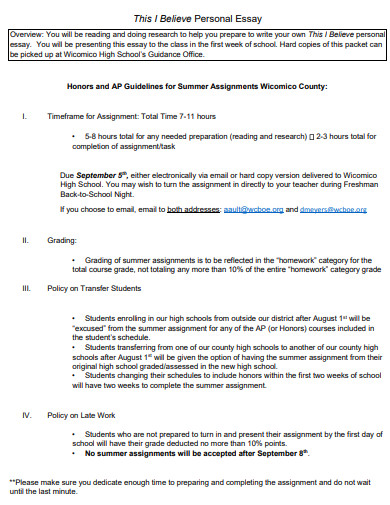
Size: 487 KB
2. Sample This I Believe Essay Example
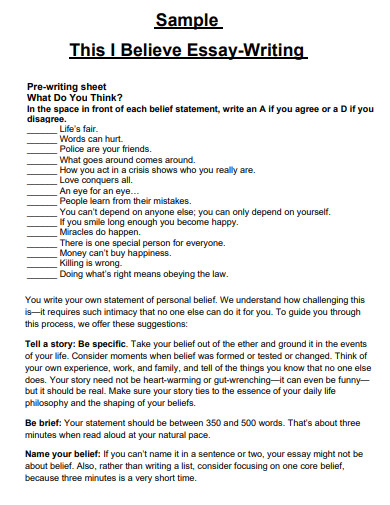
Size: 47 KB
3. Student This I Believe Essay Example
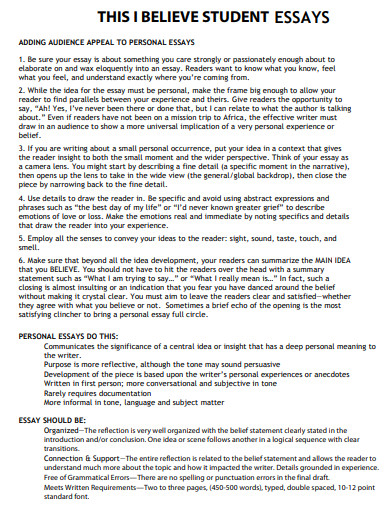
Size: 173 KB
4. Middle School This I Believe Essay Example

Size: 270 KB
5. This I Believe Essay Topic Example
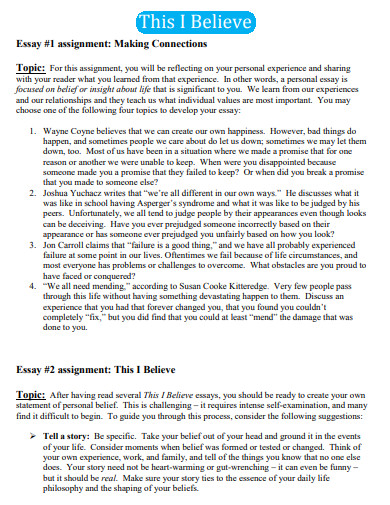
Size: 532 KB
6. This I Believe Essay Life Example

Size: 101 KB
7. This I Believe Essay Overview Example
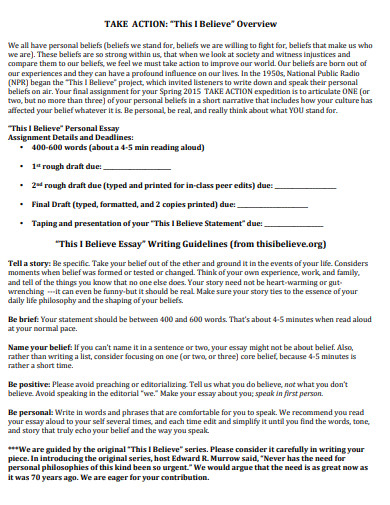
Size: 67 KB
8. This I Believe Essay Steps Example
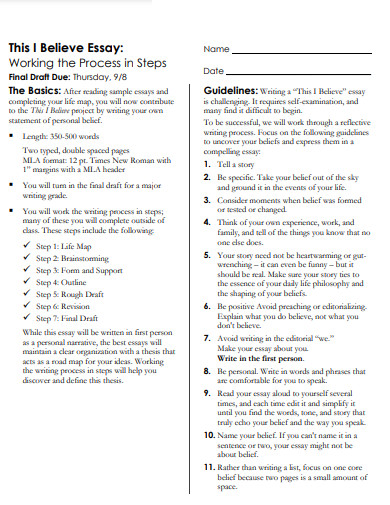
Size: 156 KB
9. This I Believe Essay Friendship Example
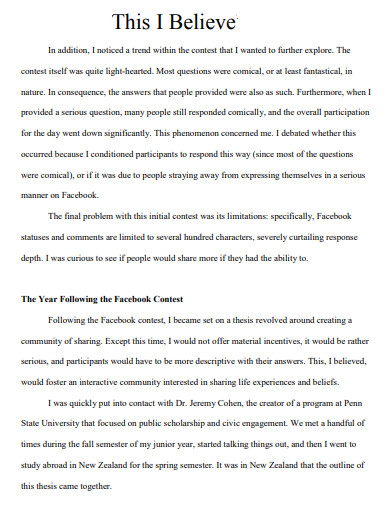
Size: 426 KB
10. Sports This I Believe Essay Example
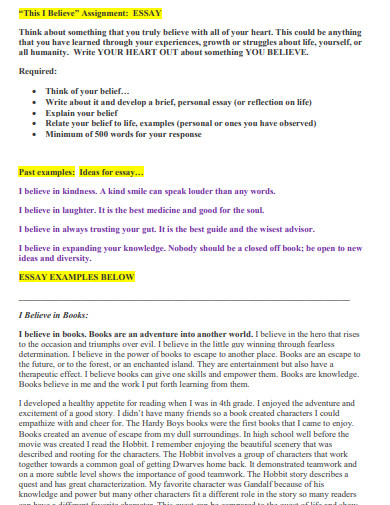
Size: 159 KB
11. This I Believe Essay Rubric Example
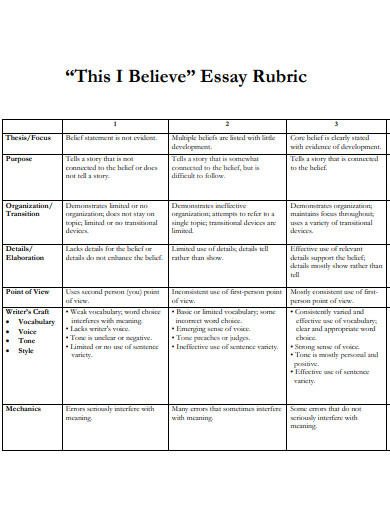
Size: 84 KB
12. This I Believe Personal Essay Example
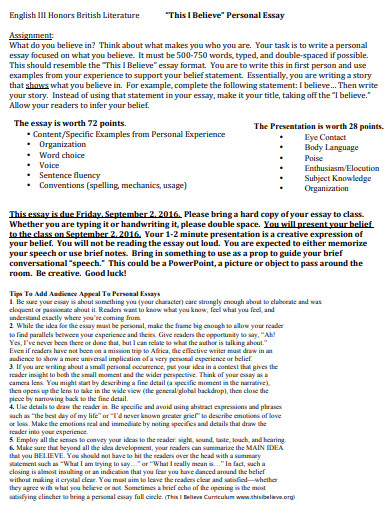
Size: 104 KB
13. This I Believe Essay Writing Example

Size: 175 KB
14. This I Believe Essay Statement Example
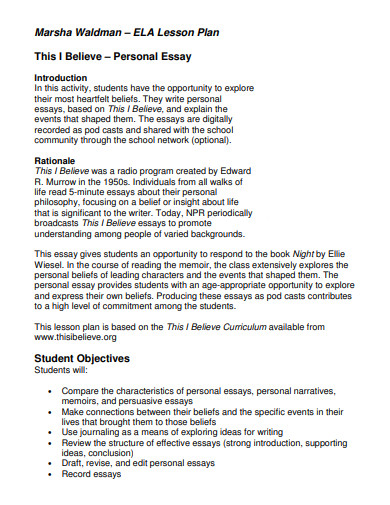
Size: 55 KB
15. God This I Believe Essay Example
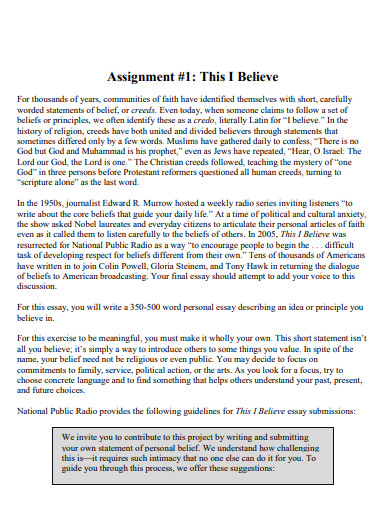
Size: 117 KB
16. This I Believe Essay Brief Example
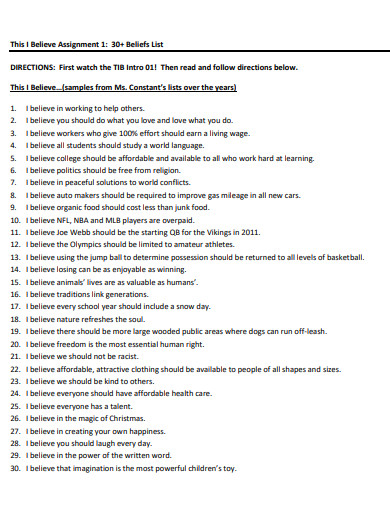
Size: 121 KB
17. This I Believe Essay Thesis Statement Example
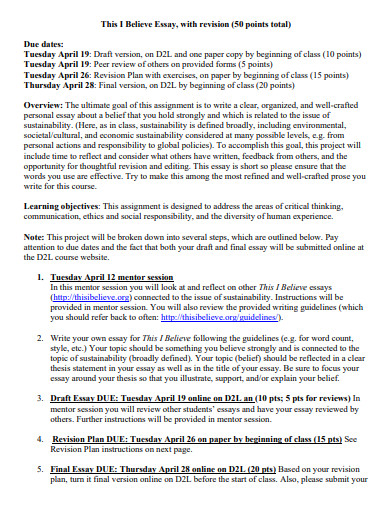
Size: 11 KB
18. This I Believe Essay Speech Example
19. this i believe essay college example.
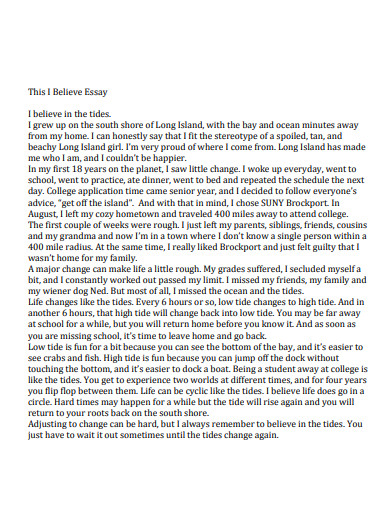
Size: 66 KB
20. This I Believe Essay Lesson Plan Example
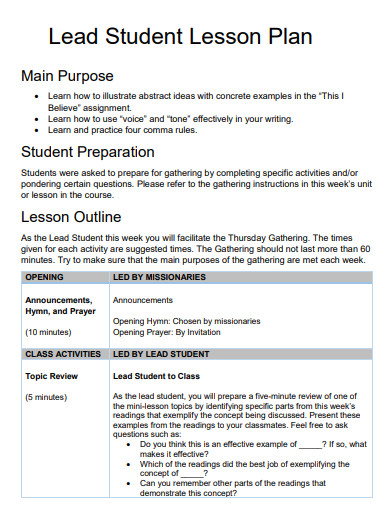
Size: 63 KB
21. This I Believe Essay Music Example
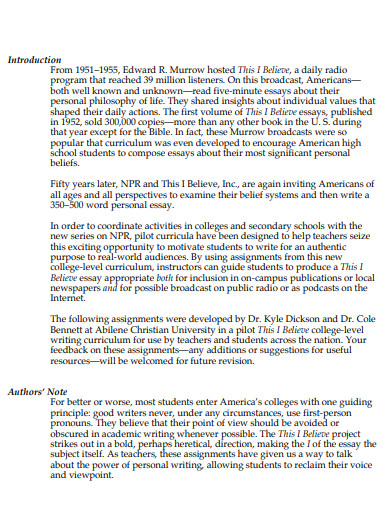
Size: 406 KB
22. Faith This I Believe Essay Example
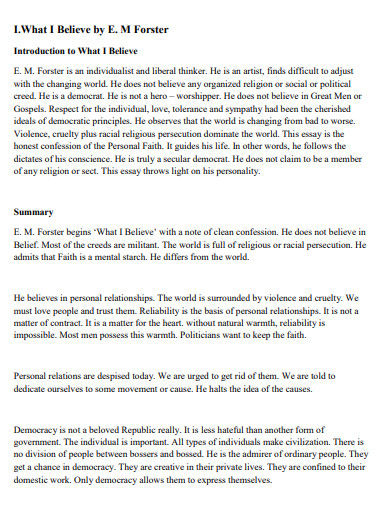
Size: 198 KB
23. Reflection This I Believe Essay Example

Size: 37 KB
24. This I Believe Immigration Essay Example
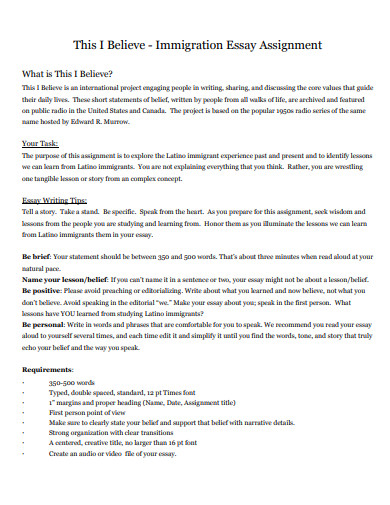
Size: 50 KB
25. This I Believe Love Essay Example
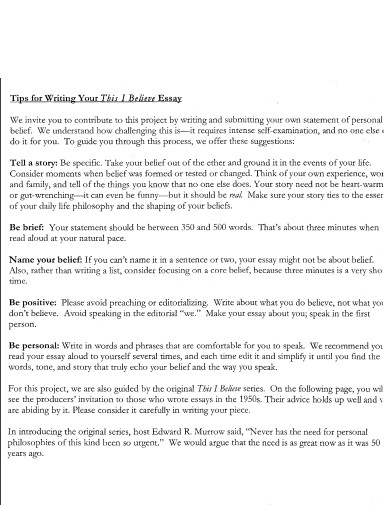
Size: 709 KB
26. This I Believe Dream Essay Example
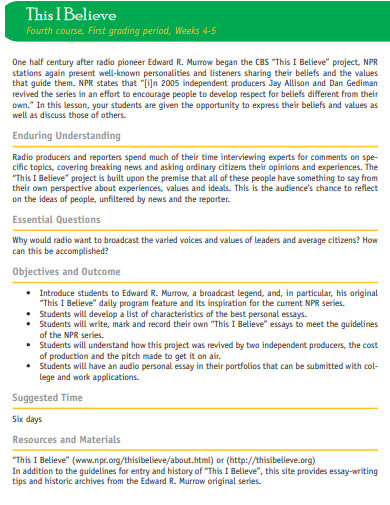
Size: 154 KB
27. This I Believe Power Essay Example
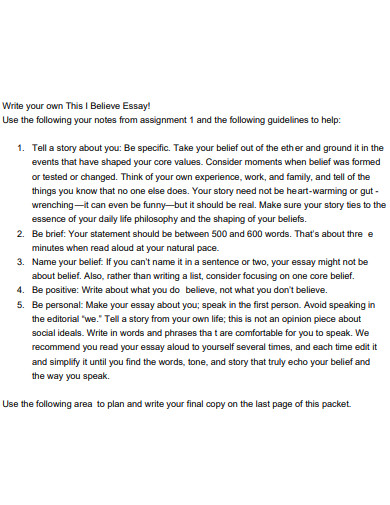
Size: 89 KB
28. This I Believe Essay Prompt Example
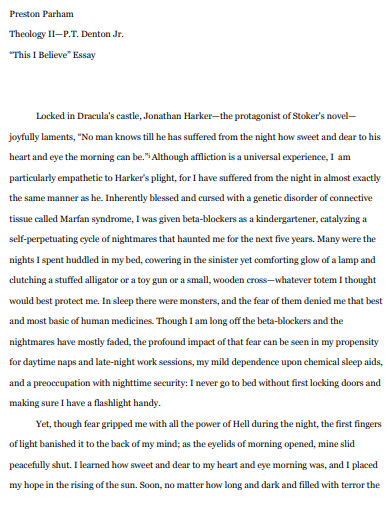
Size: 51 KB
29. This I Believe Essay Peer Review Example
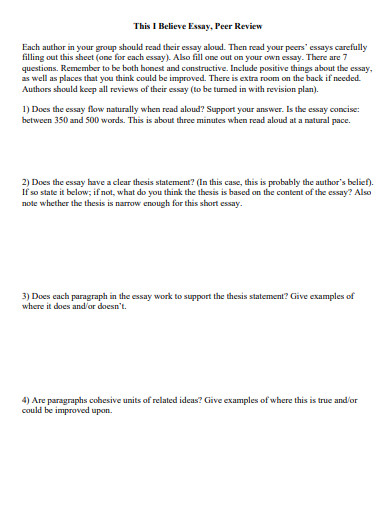
30. Elements of This I Believe Essay Example
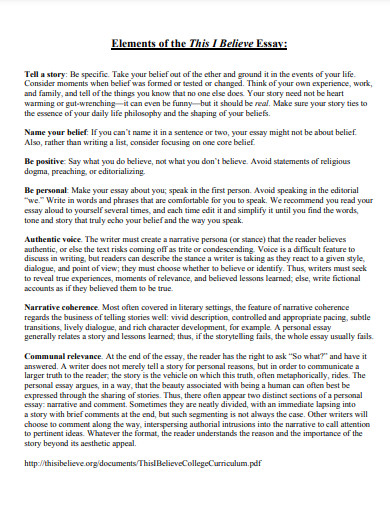
31. This I Believe Essay Transcript Example
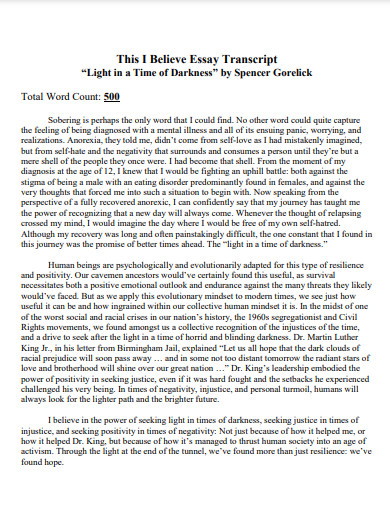
Size: 259 KB
What is a This I Believe Essay?
A This I Believe essay is a written composition that encapsulates an individual’s personal beliefs, values, and philosophies. Often reflective and intimate in nature, these essays offer readers insight into the author’s subjective understanding of the world. They provide an opportunity to explore the depth of one’s convictions, making use of various literary devices and characteristics to convey a sense of authenticity and sincerity. Through the exploration of individual experiences and convictions, these essays aim to connect with readers on a personal and emotional level.
How to Write a This I Believe Essay
Step 1: choose your core belief.
At the heart of your essay lies your core belief. Choose a belief that holds personal significance and represents your worldview. This belief should be something you feel passionately about and can articulate convincingly.
Step 2: Develop a Compelling Context
Create a context for your belief by providing background information. Explain why this belief is important to you and how it has shaped your experiences and outlook on life. A relatable context will engage your readers and make your essay more relatable.
Step 3: Employ Effective Literary Devices
Incorporate literary devices to enhance the impact of your essay. Metaphors, similes, and anecdotes can help convey your belief in a vivid and relatable manner. Consider how these devices can strengthen your narrative and connect with your audience emotionally.
Step 4: Craft a Strong Conclusion
Summarize your belief and its significance in your life, reinforcing the message you want to leave with your readers. Reflect on the journey you’ve taken them on and inspire them to reflect on their own beliefs.
Can I write about a commonly held belief?
Absolutely. While it’s important to maintain authenticity, even exploring a cliché belief can be powerful when you provide a fresh perspective or personal context. Your unique experiences and reflections make your essay stand out.
Can I use proper nouns in my essay?
Yes, proper nouns can add specificity and authenticity to your essay. Mentioning specific places, people, or events can help ground your beliefs in real-world experiences.
How can I make my essay more impactful?
Focus on using strong verbs to convey emotions and actions. Instead of saying “I felt sad,” consider saying “I crumbled under the weight of sorrow.” This adds depth to your writing and engages the reader’s senses.
In the realm of personal expression, the This I Believe essay shines as a vehicle for exploring one’s deepest convictions. By carefully selecting beliefs, weaving context, employing literary devices, and crafting strong conclusions, authors can create narratives that resonate with readers on a profound level. Through the power of words, these essays bridge the gap between individual experiences and universal truths, reminding us of the strength and diversity of human beliefs. So, take the plunge into introspection and share your beliefs with the world through the art of the This I Believe essay.

This I Believe Essay Generator
Text prompt
- Instructive
- Professional
Write a This I Believe Essay about the power of kindness in everyday life
Discuss in a This I Believe Essay how overcoming challenges has shaped your character

Want to create or adapt books like this? Learn more about how Pressbooks supports open publishing practices.
32 “This I Believe” Essay
The history of ‘this i believe’.
by Tanya Matthews
This I Believe is an exciting media project that invites individuals from all walks of life to write about and discuss the core beliefs that guide their daily lives. They share these statements in weekly broadcasts on NPR’s Morning Edition and All Things Considered .
The series is based on the 1950’s radio program This I Believe , hosted by acclaimed journalist Edward R. Murrow. Each day, some 39-million Americans gathered by their radios to hear compelling essays from the likes of Eleanor Roosevelt, Jackie Robinson, Helen Keller and Harry Truman as well as corporate leaders, cab drivers, scientists and secretaries — anyone able to distill into a few minutes the guiding principles by which they lived. Their words brought comfort and inspiration to a country worried about the Cold War, McCarthyism and racial division.
Eventually, the radio series became a cultural phenomenon. Eighty-five leading newspapers printed a weekly column based on This I Believe . A collection of essays published in 1952 sold 300,000 copies — second only to the Bible that year. The series was translated and broadcast around the globe on the Voice of America. A book of essays translated into Arabic sold 30,000 copies in just three days.
[The NPR series This I Believe can be read and heard here . In addition, the website and organization This I Believe houses thousands of essays written by famous people, such as the ones mentioned above, and everyday people like you and me.]
As a college student in 2020, you are faced with turbulent politics, socioeconomic issues, and ethical dilemmas that will challenge you to take a stand and contribute to the local, national, and global conversation around you. The purpose of this writing task is not to persuade you to agree on the same beliefs. Rather, it is to encourage you to begin the much more difficult task of developing respect for beliefs different from your own. Fifty years ago, Edward R. Murrow’s project struck such a chord with millions of Americans. It can do so again today…with you.
Video Resources for Generating Ideas
Dan gediman on writing a “this i believe essay”.
Read Cecelia Munoz’s essay “Getting Angry Can Be a Good Thing” referred to in the previous video here .
“This I Believe” Essay with Animation
“This I Believe” Essay Ideas
Prewriting Activity
1) analyze others’ statements.
Consider the following statements, written in response to the question What Have You Learned About Life? Highlight any sentences that resonate with you. Talk about them with a partner or group, explaining why. 1. I’ve learned that when I wave to people in the country, they stop what they are doing and wave back. – Age 9 2. I’ve learned that if you want to cheer yourself up, you should try cheering someone else up. – Age 14 3. I’ve learned that although it’s hard to admit it, I’m secretly glad my parents are strict with me. – Age 15 4. I’ve learned that if someone says something unkind about me, I must live so that no one will believe it. – Age 39 5. I’ve learned that there are people who love you dearly but just don’t know how to show it. – Age 42 6. I’ve learned that you can make someone’s day by simply sending them a little note. – Age 44 7. I’ve learned that the greater a person’s sense of guilt, the greater his or her need to cast blame on others. – Age 46 8. I’ve learned that no matter what happens, or how bad it seems today, life does go on, and it will be better tomorrow. – Age 48 9. I’ve learned that regardless of your relationship with your parents, you miss them terribly after they die. – Age 53 10. I’ve learned that making a living is not the same thing as making a life. – Age 58 11. I’ve learned that life sometimes gives you a second chance. – Age 62 12. I’ve learned that whenever I decide something with kindness, I usually make the right decision. – Age 66 13. I’ve learned that it pays to believe in miracles. And to tell the truth, I’ve seen several. – Age 75 14. I’ve learned that even when I have pains, I don’t have to be one. – Age 82 15. I’ve learned that every day you should reach out and touch someone. People love that human touch—holding hands, a warm hug, or just a friendly pat on the back. – Age 85 16. I’ve learned that I still have a lot to learn. – Age 92
2) Compose Your Own Statement
Write down a sentence that expresses what YOU have learned about life. Maybe it is similar to one of the statements above; maybe it’s completely different. Whatever it is, write it down.
3) Freewrit e
Now free-write about your sentence. Include at least two examples / experiences that you have had that support why you think this way.
Personal Statement/Philosophy: ______________________________________________________________________________________________________________________________________________________ Why do you believe in this statement? ______________________________________________________________________________________________________________________________________________________ Name two experiences that you had that would support the statement: _______________________________________________________________________________________________________________________________________________________________________________________________________________________________________________________________________________________________________________________________________________________________________________________ What does this say about yourself or your personality? _________________________________________________________________________________________________________________________________________________________________________________________________________________________________ After your life experience, how have you come to the conclusion that this should be your statement? How have your beliefs changed, if at all? ____________________________________________________________________________________________________________________________________________________________________________________________________________________________________________________________________________________________________________ How has the event effected your relationship with a person, place, or object? _________________________________________________________________________________________________________________________________________________________________________________________________________________________________ How does your statement apply to you today? (How you view yourself & society) ______________________________________________________________________________________________________________________________________________________
SAMPLE STUDENT ESSAYS
Sample #1: america’s beauty is in its diversity.
written by Alaa El-Saad, high school student, as heard on NPR’s Tell Me More (2009)
America is built on the idea of freedom, and there is no exception for Muslim women. I believe in the freedom of religion and speech. But mostly, I believe it’s OK to be different, and to stand up for who and what you are. So I believe in wearing the hijab.
The hijab is a religious head covering, like a scarf. I am Muslim and keeping my head covered is a sign of maturity and respect toward my religion and to Allah’s will. To be honest, I also like to wear it to be different. I don’t usually like to do what everyone else is doing. I want to be an individual, not just part of the crowd. But when I first wore it, I was also afraid of the reaction that I’d get at school.
I decided on my own that sixth grade was the time I should start wearing the hijab. I was scared about what the kids would say or even do to me. I thought they might make fun of me, or even be scared of me and pull off my headscarf. Kids at that age usually like to be all the same, and there’s little or no acceptance for being different.
On the first day of school, I put all those negative thoughts behind my back and walked in with my head held high. I was holding my breath a little, but inside I was also proud to be a Muslim, proud to be wearing the hijab, proud to be different.
I was wrong about everything I thought the kids would say or even do to me. I actually met a lot of people because of wearing my head covering. Most of the kids would come and ask me questions—respectfully—about the hijab, and why I wore it.
I did hear some kid was making fun of me, but there was one girl—she wasn’t even in my class, we never really talked much—and she stood up for me, and I wasn’t even there! I made a lot of new friends that year, friends that I still have until this very day, five years later.
Yes, I’m different, but everyone is different here, in one way or another. This is the beauty of America. I believe in what America is built on: all different religions, races and beliefs. Different everything.
Sample #2: The Essentials to Happiness
written by Alexxandra Schuman, high school student, as heard on The Bob Edwards Show (2013)
As a child, I was generally happy; singing and dancing to my favorite songs; smiling and laughing with my friends and family. But as far back as second grade, I noticed a “darkness,” about me. I didn’t enjoy engaging in many things. I didn’t relate to my peers in elementary school because they appeared so happy, and I didn’t have that ability to achieve happiness so easily.
In middle school things in my life began to get even worse. I began withdrawing from everything I once enjoyed; swimming, tennis, family. I hated going to sleep knowing I had to wake up to another day. I was always tired. Everything was horrible. Finally, midway through eighth grade, I was told I had a chemical imbalance; diagnosed with clinical depression and put on medication. It took months for me to feel the effects of the medication.
When I began to feel happy again, is when I realized that I had to take the responsibility for getting better myself, rather than relying on medication and therapy alone. Aristotle said, “To live happily is an inward power of the soul,” and I believe that this quote describes what I had to do to achieve happiness. Happiness is a journey. Everyone seems to need different things to be happy. But I believe people are blinded from what truly makes one happy.
Growing up, we’re encouraged to be successful in life; but how is success defined? Success and happiness are imagined now as having a lot of money. It is so untrue. Recently I went to Costa Rica and visited the small town of El Roble. I spent the day with a nine-year old girl named Marilyn. She took me to her house to meet her parents. It was obvious that they were not rich; living in a small house with seven children. The house was cluttered but full of life. Those who have decided that success and happiness comes from having money and a big house would be appalled at how utterly happy this family from El Roble is. People say that seeing things like that make you appreciate what you have, but for me, it made me envy them for being so happy without all the things I have.
“The essentials to happiness are something to love, something to do, and something to hope for,” a quote from William Blake sums up what I believe people need to realize to be truly happy in life. People need love; I feel they need their family and their friends more than anything in the world. People need work to do, something to make them feel they are making a difference in the world. People need to know that more good is to come in the future, so they continue to live for “now” instead of constantly worrying about the bad that could come. And most importantly people need to know that happiness is not something that happens overnight. Love and hope is happiness.

Sample #3: Find a Good Frog
written by Delia Motavalli, high school student, as heard on The Bob Edwards Show (2013)
I believe in finding a good frog. It seems that all throughout childhood, we are taught to look for a happily ever after. “And they all lived happily ever after”; isn’t that the conclusion to many children’s films? When I was a kid I always thought of that as magical; but now really it just seems unrealistic. And it teaches us that what we want is a fairytale like they have in the storybooks. We all want to be Cinderella who gets swept off her feet by the hot prince; we want to live in the royal castle, right? But I don’t think that’s necessarily a good thing for us to seek. Now I’m not saying I believe in being pessimistic, but I do believe in being realistic; it’s something I got from my mom.
My mother and I always have our best conversations in the rain. We sit in the car, neither of us wanting to brave the rain to get to the house. So we sit. We watch droplets race down the windshield, listen to the rain strike the roof of her little blue Honda, and feel the heater on full-blast rushing at our feet (just the way we like it). I don’t know why, but sitting in the car, we always talk more than normal. There was one rainy day when my mom told me something that is going to stick with me forever. Earlier that day she and my dad had been arguing about something; I can’t remember what. So she said, “Don’t spend your life looking for Prince Charming. Instead, find yourself a really good frog.”
At the time, I found this thought really disheartening. Who wants to think that you’ll never find Prince Charming? You’ll never get to be Cinderella? Another thought that struck my mind: if my mom says there’s no Prince Charming, then what’s my dad? A frog? I asked her, and she replied with, “Of course! If he were Prince Charming, he wouldn’t snore, would be able to cook, and we would never argue. But you know what? He’s a damn good frog.” Of course, being young, I didn’t think of the meaning behind what she was saying. I was too busy thinking of it literally, visualizing my mom as a princess and my dad in frog form.
But a few years later, I understand the value of my mom’s words. You can’t expect everything to be perfect. Let’s be completely honest; if you wait your whole life for your prince with flowing hair, statuesque features, and a white horse, you’re going to be lonely. I think that the point of finding a good frog is you accept something that’s great, flaws and all. It’s so easy to be picky. You can find the one tiny thing that’s wrong, and that one tiny thing is what you can’t get your mind off of. But in life, we can’t afford to wait years in vain for perfection. So I think that a good frog, an amazing frog, the best frog you can find is what we’re really looking for in this world. Don’t laze through life waiting for a happily ever after, because I don’t think you’ll be very happy with the outcome.
Examples from the ‘This I Believe’ Website
Be Cool to the Pizza Dude by Sarah Adams
They Lived Their Faith by Charles Henry Parrish
Returning to What’s Natural by Amelia Baxter-Stoltzfus
The Birthright of Human Dignity by Will Thomas
Remembering All The Boys by Elvia Bautista
I Am Still The Greatest by Muhammad Ali
A Goal Of Service To Humankind by Anthony Fauci
My Life Is Better by Abraham
Give Me a Waffle by Brenda
The Little Things by Sophie Crossley
You can also browse thousands more This I Believe essays by theme .
Prefer to Listen to Get Inspiration?
Check out This I Believe’s Podcast Series
4) Drafting
Assignment guidelines + suggestions and tips for drafting.
1. While the examples you’ve been given can serve as a model, it is essential that each of you write about a personal belief or philosophy that you feel strongly about. 2. Tell a story. Personal experiences are the corner stone of a good essay. Your story doesn’t have to be a heart breaker or even a major event, but it must be something that has affected how you think, feel, and act. List your personal experiences that you intend to use as evidence below: 3. Be concise. Avoid repetition. This essay should be between 500 – 650 words. When read aloud, it should take roughly four minutes. 4. Name your belief. It is essential that you can name your belief in a sentence or two. Focus on one belief only. This is your thesis. Write it here: 5. Be positive. Avoid preaching or persuading. You aren’t trying to change the way others think or act. Write about what you believe, not what you don’t believe. 6. Use the first person. Speak for yourself. Avoid using we or you. 7. Let your voice shine. Use language that sounds like you. Read it aloud as your revise. Keep making changes until your essay sounds like you and captures the essence of your belief.
5) Peer Review
Once you have written your first draft, arrange for your essay to be edited by a peer, using the following Peer-Editing Checklist: Writer’s Name: ________________________________________________ Peer Editor’s Name: ________________________________________________ Use your PENCIL or PEN (NOT red or green) to make corrections. Remember, this essay is a work in progress. You are not done writing! Look for ways to improve what you’ve already written. Tick each step if it has been completed. _____ 1. Read the paper backwards, one sentence at a time. Check for spelling errors. Use a dictionary, a friend, or a spell checker to find the correct spelling. _____ 2. Check for capitalized proper nouns and the first word of each sentence. _____ 3. Skip a line between each paragraph. _____ 4. Every sentence should have end punctuation. _____ 5. Check commas. Are they only used for compound sentences, a list of items, an introductory word or phrase, direct address, setting off interruptions, separating adjectives, or in dates? Do you need to add commas? Make sure you do not have commas separating complete sentences (i.e. comma splice errors that create run-on sentences). _____ 6. Apostrophes are used only for contractions and to show ownership. _____ 7. The use of more complex punctuation (dashes, hyphens, semi-colons, parentheses, etc.) is done correctly. _____ 8. Have you used commonly mixed pairs of words correctly? Check these: they’re/their/there, your/you’re, it’s/its, a/an, to/too/two, are/our/hour, and others. _____ 9. Read the paper backwards one sentence at a time. Check for sentence fragments and run-ons and correct them. _____ 10. Did you stay in present tense (such as is, am, do, take, know, etc.) or past tense (such as was, were, did, took, knew, etc.) throughout the entire essay? _____ 11. Did you stay in first person (I, me, my, we, us, our) or third person (he, him, she, her, they, them, their) throughout the entire essay? _____ 12. Was there adequate use of specific details and sensory details? Were the details clear and relevant to the statement? _____ 13. Is the overall purpose/philosophy clear? _____ 14. Does the conclusion make you go, “Wow!” “Cool!” “I never thought about it that way,” or any other similar reaction? Other suggestions for the overall content of the piece: ____________________________________________________________________________________________________________________________________________________________________________________________________________________________________________________________________________________________________________
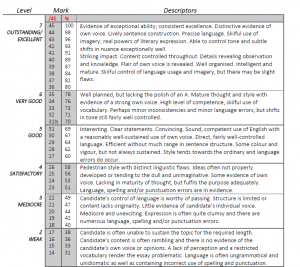
This I Believe by Tanya Matthews is licensed by CC-BY-SA
“This I Believe” Essay Copyright © 2020 by Liza Long; Amy Minervini; and Joel Gladd is licensed under a Creative Commons Attribution-ShareAlike 4.0 International License , except where otherwise noted.
Share This Book
- Skip to main content
- Keyboard shortcuts for audio player
This I Believe
- Subscribe to NPR's Up First Email
Celebrating Four Years Of 'This I Believe'
April 27, 2009 • During its four-year run on NPR, This I Believe engaged listeners in a discussion of the core beliefs that guide their daily lives. We heard from people of all walks of life — the very young and the very old, the famous and the previously unknown.
Saying Thanks To My Ghosts
April 26, 2009 • Novelist Amy Tan hasn't always believed in ghosts, but as a writer she's had too many inspirations that she can't fully explain. Now, Tan embraces her belief in ghosts and the messages of joy, love and peace they bring her.
Life Is An Act Of Literary Creation
April 23, 2009 • Mexican-American novelist Luis Urrea used to think that simply being a good observer would make his writing better. But over time, he's come to believe that being a good writer and a good person comes from paying attention to the world around him.
The Art Of Being A Neighbor
April 12, 2009 • A few years ago, Eve Birch was broke and living alone in a dilapidated mountain shack. But a community of people befriended her, shared what little they had with her and showed Birch the value of neighbors uniting to help one another.

Muhammad Ali John Lair/Muhammad Ali Center hide caption
I Am Still The Greatest
April 6, 2009 • To be the "Greatest of All Time," boxing legend Muhammad Ali says you have to believe in yourself. It's a lesson his parents taught him and it has helped him in fighting Parkinson's disease.
Dancing To Connect To A Global Tribe
March 29, 2009 • Matt Harding has been to 70 countries to dance — badly — in front of a camera, and videos of his travels have become an Internet sensation. Harding believes interacting with so many different people challenges him to understand what unites humanity.
My Father Deserves Spectacular Results
March 26, 2009 • Environmental activist Van Jones is a special adviser to the Obama administration. He says his dad, who died last year, would have gotten a kick out of seeing Obama become president. But his dad had high standards, and there is much more work to be done.
The Beatles Live On
March 15, 2009 • Macklin Levine was born more than 25 years after the Fab Four broke up, but at 12, she has a deep appreciation for Beatles music. "As old as the songs are, you can learn a lot about yourself from the lyrics," she says. And the Beatles help her remember her Dad, too.
Finding Freedom In Forgiveness
March 5, 2009 • Jennifer Thompson-Cannino was certain that Ronald Cotton was the man who raped her in 1984. But she was wrong. After Cotton spent 11 years in jail, DNA evidence proved his innocence. Now, the two have a friendship based on their belief in forgiveness.
Work Is A Blessing
March 1, 2009 • When he was 12, Russel Honore got his first job helping a neighbor milk 65 dairy cows twice a day. Fifty years later, the retired Army lieutenant general believes hard work helps build character, strengthen communities and promote freedom.
Seeing Beyond Our Differences
February 26, 2009 • Scientist Sheri White says that despite differences in size, shape and color, all humans are 99.9 percent biologically identical. White believes we should embrace our similarities and honor the differences that make each of us unique.
Historical Archives
Reflections on race: essays from the archives.
February 23, 2009 • Dan Gediman, executive producer of NPR's This I Believe, explores the archives of the original series hosted by Edward R. Murrow in the 1950s. He says the essays shed light on the realities of segregation at the dawn of the civil rights movement.
Gediman explores the 'This I Believe' archives.
The magic of letters.
February 15, 2009 • Chameli Waiba was raised in a village in Nepal and didn't attend school as a child. When she finally learned to read as an adult, Waiba discovered the power words could have to change her life, as well as the lives of others in her rural community.
How To Survive Life's Tests
February 9, 2009 • Kendra Jones assigned her students to write This I Believe essays and decided that she owed it to them to write one of her own. Jones believes toughness, steeliness and even meanness have helped her throughout her life.
Our Awareness Controls Human Destiny
February 8, 2009 • In an essay from 1951 for the original This I Believe series, Margaret Mead says she can't separate the beliefs she has as a person from the beliefs she has as an anthropologist. She says that humans have a responsibility for the entire planet.
A Hope For Bettering Humanity
February 1, 2009 • In an essay from 1953 for the original This I Believe series, Sir Charles Galton Darwin, the grandson of naturalist Charles Darwin, drew on his study of science to say he believed the future of humanity depended on the practice of eugenics.
Listening Is Powerful Medicine
February 1, 2009 • It took a scolding from an elderly patient to get Dr. Alicia Conill to look up from her charts and stop to listen. Conill came to understand the value of listening in the treatment process — especially when she herself became the patient.
America's Beauty Is In Its Diversity
January 29, 2009 • In sixth grade, Alaa El-Saad decided to start wearing the hijab , a religious head covering for Muslim women. Despite some trepidation, she found her classmates supported her choice. Now El-Saad believes being different is part of being American.
Thirty Things I Believe
January 18, 2009 • When Tarak McLain's kindergarten group celebrated their 100th day of class, some kids brought 100 nuts or cotton balls. Tarak brought a list of 100 things he believes. Now a first-grader, Tarak shares his top beliefs about God, life, nature and war.
Inviting The World To Dinner
January 12, 2009 • Every Sunday for 30 years, Jim Haynes has welcomed complete strangers into his Paris home for dinner. By introducing people to each other and encouraging them to make personal connections, Haynes believes he can foster greater tolerance in the world.
Pathways Of Desire
January 4, 2009 • Gina Parosa believes in letting her kids, pets and livestock make their own paths in life. But she also realizes that as a farmer and parent, she sometimes has to step in and set good boundaries — while still being flexible enough to change them.
This Is Home
January 1, 2009 • Majora Carter believes you don't have to move out of your old neighborhood to live in a better one. Carter was raised in the South Bronx and spent years trying to leave. But when the city proposed a waste facility there, she was inspired to fight for her community.
Health Is A Human Right
December 21, 2008 • As an infectious disease specialist, Dr. Paul Farmer has traveled the planet to organize and provide medical treatment for people living in poverty. He believes good health care is vital but just the first step in creating a world free of all human suffering.

Listen... a sound collage from This I Believe from NPR
About this i believe.
This I Believe was an international project engaging people in writing, sharing, and discussing the core values that guide their daily lives. These short statements of belief, written by people from all walks of life, are archived online in perpetuity. Selected essays aired on National Public Radio from 2005 to 2009, and were collected in a New York Times bestselling book; further collections of NPR-aired essays were also published.
Atlantic Public Media served as the independent production team for the long-running and acclaimed NPR series, This I Believe .
Jay Allison was the curator. Viki Merrick was editor. The series also produced best-selling books which are still used in schools and colleges today.

Listen... Eboo Patel on This I Believe
In 2005 and 2006, USA Weekend invited its readers to participate in the project and published selected essays from their readers. Numerous local public radio stations, newspapers, and magazines have featured essays from citizens in their communities. In 2008 Atlantic Public Media helped Madhu Acharya create a Nepali version of This I Believe .
The series spawned an outreach structure to bring this program to the attention of schools and other community groups, and the books have become popular with “one book, one community” projects.
The project was based on the popular 1950s radio series of the same name hosted by Edward R. Murrow.

Listen... Dennis Downey on This I Believe
Related links.
- More audio stories from This I Believe at NPR’s website
- License This I Believe at PRX

Social Networks
Power Lesson: “This I Believe” Essays
December 4, 2016
Can't find what you are looking for? Contact Us
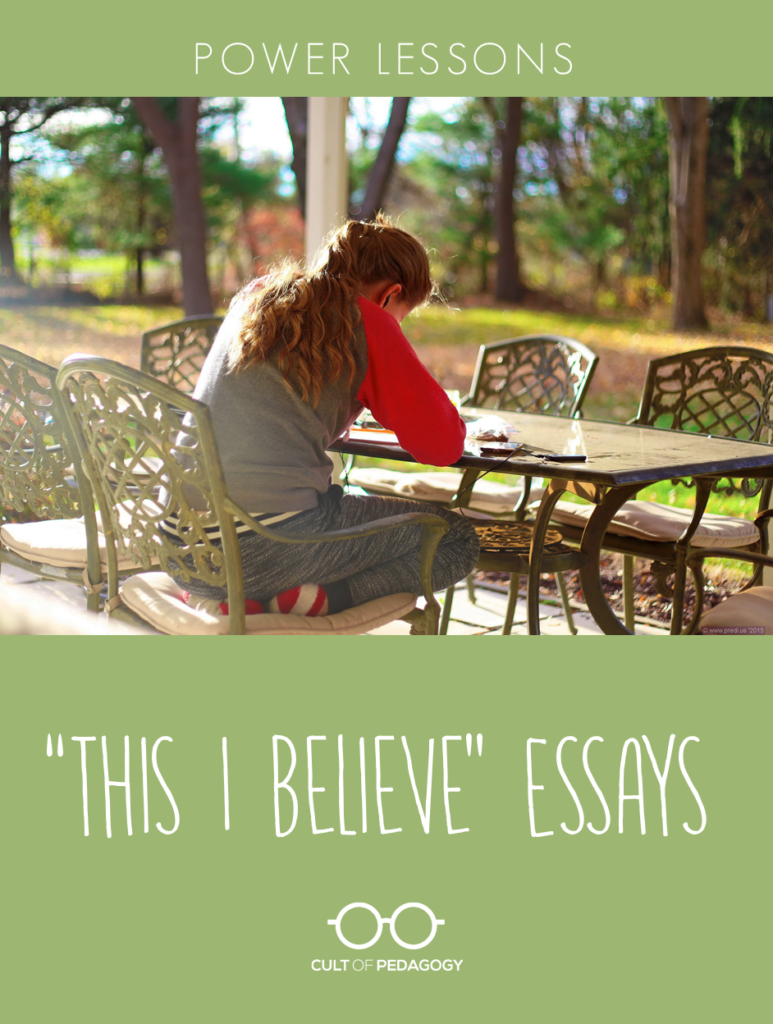
“Doing homework” by Predi is licensed under CC BY-ND 2.0
In this power lesson shared by high school English teacher Cynthia Ruiz , students write their own personal statements of belief. The essay pushes students to write about something that matters to them and helps them get to know each other on a deeper level.
I used to assign a “Letter to the Teacher” at the beginning of every year to get a snapshot of how a student writes while simultaneously learning background information. Being completely honest, this assignment is also an easy way to get the first few back-to-school days started when a 90-minute class period feels like 900 minutes, because everyone is typically on their best behavior and not talking much. Although I enjoy reading the letters, the assignment doesn’t lend itself to revising and is written only for a specific, one-person audience.
I know building relationships with students is important and a way to get to know them is through their writing, so I did some research to see what other teachers were trying. I came across the “This I Believe” site and immediately liked the concept better than an introduction letter for a teacher.
Assignment Guidelines
The first time I assigned a “This I Believe” essay was in the fall of 2014, during the second week of school. I planned it as a year-long endeavor, something we could work on as a distraction from other essays required to prepare for state testing. This past year, I did not assign it until late April; it would be our last major writing task. I wanted to give everyone plenty of time to write but held them to a firm deadline of having four weeks to work.
This time, I crafted my writing guidelines according to those posted on the NPR site that hosts hundreds of This I Believe essays from around the world. My rubric still has some typical writing conventions, but overall I think it focuses more on student voice than structure. I made it clear that students had a lot of choice regarding both content and format. The biggest restriction came directly from the This I Believe site: a 500-600 word limit. I know a lot of writing teachers are divided when it comes to word count, but I figured it was still better than giving a specific number of required paragraphs and sentences.
One other requirement was that students use at least three “vocabulary devices.” This may seem like a restriction, but it actually supported student voice. Over the spring semester, we spent a lot of time reviewing both rhetorical and literary devices (anaphora, hypothetical questions, simile) and I told students to focus on the devices they genuinely felt comfortable using.
Helping Students Choose a Topic
Because the rubric leaves room for a lot of choice, I encouraged students to visit the featured essays site and not only read, but listen to real examples. I wanted them to see that this wasn’t just another run-of-the-mill assignment, that what they believe is important and writing is just one way to share those beliefs. I also made it a point to tell them our end goal was to share this essay with their entire class by way of a gallery walk.
After giving students time to explore the site, I had them “rush write” in their notebooks to see what immediate ideas they captured to help start the brainstorming process. Here’s the prompt I used:
This I Believe For 2 minutes: List words or ideas that you think about when you think of YOUR LIFE. (Can be feelings, symbols, names, events, etc.)
After students generated this list, I asked them to consider what they wanted to write about and share with others. I wanted them to imagine a larger audience and think outside of meeting my expectations.
For some, deciding what to write about was easy and they began drafting immediately. However, the majority of students struggled not so much with what they believe, but how to write about it. Even though they appreciated having so much choice, they still needed some direction to get started.
We continued the listing strategy by focusing on “most memorables”: most memorable events in life so far, most memorable stuffed animal, most memorable friends, family experiences, life lessons learned, and so on. I asked them to focus on why they remember what they remember, and whether or not it impacts any of their beliefs. One student remembered a saying his grandmother always told him that still provides comfort as he’s gotten older. Another focused on her family not having a big house when they first moved to America and how she’s learned to be satisfied with opportunities instead of possessions. While this strategy helped a lot of light bulbs go off, it didn’t work for everyone.
Another strategy I tried was using involved sentence stems: I know I am the way I am today because______. I know I think about things the way I do because _______. I think most people would describe me as ______. I emphasized that these phrases did not have to be included in their final products, but should help generate ideas. I talked with a few frustrated students about this strategy and they told me it made them realize they’ve never really had to think about themselves in this way, but ultimately, it gave them direction for their essays.
Drafting and Revising
Because of block scheduling, I gave students about a week and a half to complete a working draft, which required having at least two paragraphs of their essay done. I only gave a portion of two to three class periods to actually write in class; students were expected to write on their own time.
On the day drafts were due, I set aside class time for revision. I asked students to refer to the rubric and focus on voice and vocabulary strategies. Questions I told them to consider were: Does this sound like me? Do I talk like this to my friends or family? I gave students the option of reviewing their own essays or partnering up with someone to peer edit. Again, this was the end of the year, so we had already established a pretty firm community of trust in class. I don’t know if peer editing would have been as easy had I done the assignment early in the year.
Overall, draft day didn’t feel like the usual “revising and editing” days we’ve had with other essays. Students were very concerned with whether or not they were making sense, if they should add more, or if they were being too repetitive, rather than only being concerned about capitalization, spelling, and grammatical errors.
Sharing the Finished Essays
The culmination of this assignment was when the essays were shared in a gallery walk . The gallery walk is my answer to having students write for a larger audience, and it really helps this essay become about what students have to say instead of just another grade. I can’t count how many times I have returned tediously graded essays only to have a kid immediately walk over to the recycling bin and trash it! Sure he read the comments and suggestions I made, or saw the cute smiley face I left by an excellent word choice, but it didn’t mean much to him because the paper is graded and finished, and he is now done thinking about it. With a gallery walk, not only are students thinking about what they wrote, but they have the opportunity to think about what their classmates wrote as well.
I printed each essay without any names, and made sure any identifying statements were revised. However, there were quite a few students who said they were proud of what they wrote and had no problem if others knew which essay belonged to them. Because not every student turned in a final copy, I printed additional copies of some completed essays to ensure every student had something to read during our gallery walk, instead of drawing attention to the two or three students who did not finish the assignment.
I placed the essays on different tables throughout the room and allowed students to move around as needed; some chose to stand and read an essay, others opted to sit, while others sprawled out on the floor to read. I played soft music and asked that the room volume stay quiet enough to be able to hear the music at all times. I didn’t mind if students were sharing and discussing, and I really wish I recorded the various conversations and comments I overheard that day: “Wow! Did you read this one yet?” “Man. Who wrote this? I might cry. Good tears, though.” “This one is life, Ms. Ruiz.”
I provided a pad of post-its near each essay and told students to leave POSITIVE feedback for each other. I provided sentence stems to help:
Something I liked…
Something I can relate to/agree with…
Something that surprised me…
Something I want to know more about…
I really think…
I periodically checked to make sure no one was being inappropriately critical or just leaving cute hearts or check marks. I wanted students to think about what they were reading, and understand that feedback is a crucial part of the writing process
After about 40 minutes, each essay had received multiple written comments, looking similar to the picture below:
Overall, the feedback was uplifting and actually created a sense of belonging in each class. Students told me they learned so much about each other that day and were shocked by their classmates’ writing. A few said they wished they had written this essay sooner.
Sample Student Work
I was floored by some of the essays I received. Some made me laugh, some made me gasp, some made me cry. Compared to the typical papers I usually assign, this essay allowed my students to not just think about what they were writing but to care about their writing and to be intentional in the language they were using, both in word choice and rhetorical strategies, because it was about what they believe. It is some of the strongest student writing I have ever received as an English teacher.
Here are some sample paragraphs from students who gave me permission to share their work:
From a student who told me he hates school and hates writing.
From a student who by all outward appearances, comes from a traditional family.
From a student battling depression and anxiety.
From a student who missed almost a whole semester but is trying to stay in school.
Although this essay helped end the year with a strong sense of community, I think teachers could easily have students write it at the beginning of the school year or even in January at the start of a new year. I’d love to hear how other teachers have used an essay like this in their classes. ♦
Have you taught a lesson or designed a learning experience we should feature in Power Lessons? Send a full description of your lesson through our contact form and we’ll check it out!
What to Read Next

Categories: Instruction
Tags: English language arts , lesson planning , power lessons
39 Comments
Cynthia and Jennifer, Thank you for sharing this Power Lesson; it’s one I plan on “borrowing” for sure in January. I love the connection built during the gallery walk. I can imagine this being truly powerful for all students. Well done!
I LOVE this!! I will use this in the Spring with my students. The excerpts in the blog post were so personal. I hope the students realize what a gift they shared.
Tonya, I agree. I’m always so grateful when students are willing to let us see their work here!
I love this assignment. I use it every semester with Public Speaking students, following a similar brainstorm and drafting process. Since the assignment comes from a radio program, my students audio record themselves, and our celebration of the work happens through hearing each student read the essay. Very powerful hearing their voices!
Ruth, thanks so much for taking the time to share this idea. I’m sure lots of teachers will love how audio enriches this assignment.
Thank you for sharing the students’ samples. Writing is such a great way to express oneself and when you make it personal students are engaged. ❤️ it! I am thinking about adding it as my last assignment for my 3rd graders!
Thank you for sharing, especially the students’ work samples.This will help inspire my students to share important details about their lives. Might I also recommend an excellent book I purchased used recently: Reading, Writing and Rising Up (by Linda Christensen)
I like this writing strategy. Last week I started something similar with my Arabic students. In groups of 3 to 4 students, they wrote stories (Brainstorm, first draft…) They started writing their final draft(with illustrations and drawings) on the butcher paper. On Monday, they will hang it on the wall and they will give each other feed back wile walking and reading each other’s essays. The problem with the foreign languages students writing is that they have brilliant ideas in English, but they cannot express them in Arabic or French… My questions is the following: Is there a way to adapt this writing strategy to World Languages students with taking into consideration the limited students’ language levels.
I love this assignment. I use at the end of the year with my seniors. I tell them to focus on a belief that they have formed over their past years of school and that will guide them as they make steps on their next journey — college, military, work, etc. Every year I am awed by the thought and pride they take in it. Their voices shine through the papers. The emotions, ranging from joy to sadness or humor to regret, overtake their essay making each both personal and universal. I also always write one that I individualize for each class and how they have shaped or firmed one of my own beliefs.
I love this, especially as a way to “re-enter” in January! I hope that I can use it effectively with my middle schoolers. Thank you so much for sharing this!
YES!! This was my first lesson in my first year of teaching and it completely set the tone for the rest of the year. The work I received from eleven year olds blew my mind, and I even submitted(with their permission) a few pieces to be published because they were that deep. Bravo to this I believe essays & sharing lessons like this with other educators.
Did you find that you had to add in any scaffolds/support for students? I want to try this with my 7th graders who really struggle with writing and getting started with ideas.
This looks like a fabulous project and one I am keen to try out next semester.
I, too, have been doing this assignment for a few years now. It is my favorite assignment of the year. I teach 8th grade English and I have my students share their essays aloud. We sit in a circle and listen to each student share his/her belief. It is powerful. We laugh. We cry. We learn. Having students write for an audience of their peers is challenging for them, but so rewarding in the end.
This looks great for January. I noticed that the This I Believe website has a high school curriculum for sale for $20. Has anyone used it? Is it worth it? Necessary?
This reminds me of an assignment I had in high school. It was called our “Capstone,” and was a year-long process (12th grade). We first chose three things that were important to our lives: a person, a place, and an event. Over the first semester we wrote about these in three separate papers. Then come second semester we had to connect them with a metaphor, and put together a 20 minute presentation that connected everything. It really allowed students to get creative while expressing what was most important to us.
Do you happen to have an example of this still? It sounds AWESOME and I would love to do it with my 8th graders!
Your students’ essays are beautiful, authentic and inspiring, as I am sure your teaching is. Thank you for sharing.
Thanks for the lesson. I like this idea for journaling too!
A brilliant idea! Thanks!
Thanks for sharing and including student work examples. Essays like this are a great way to get to know students at a deeper level and could also make a good college entrance essay!
Thank you for sharing this. Inspirational and heartfelt writing from young people.
This is so inspiring and beautiful. Thank you so much, both of you for sharing this power lesson. I was lookibng for a writing task muy ss could include in their e-Portafolio. Can’t wait to try it!! Thank you again!!
I know this might be simplistic, but could you share more about the vocabulary devices?
Hi, April! For the vocabulary devices, I’m referring to adding similes, metaphors, hyperboles, imagery, etc. We usually practice devices like anaphora and asyndeton in my advanced classes, so those can also be used. One of my favorite lines this year was: “I mean, I thought a step stool would do the job but instead it was like climbing a 20 foot ladder just to finish my goal…” We talked about how using a vocab device is more powerful than “I worked really hard.” Hope that helps! Cheers!
This is sooooo great!! I love it!!!!!
I love this. Has anyone tried it at the start if the year? Are students willing to write about such personal experiences and beliefs with a teacher and classmates that they don’t know well?
Hi Lizzie! I work for Cult of Pedagogy, but I’m replying as a teacher. I teach college level freshman comp and I started my previous semester with this essay. Because it was the beginning of the year, I didn’t do a gallery walk; it was more of a practice assignment to get used to the flow of papers and feedback. They had to bring in a rough draft for in-class workshops, so I made sure they knew a few of their classmates would be reading what they wrote. For extra credit, I offered them the chance to record their paper as a “podcast” and post it on YouTube. I was blown away by how in-depth most of them went! In fact, I’m starting my fall semester with it again.
I love this assignment in the spring for senior English. Generally, kids are appreciative that we’re doing the final writing assignment about something that is ‘real world legit’. I’ve always been impressed by their level of attention (and attendance),as our gallery walk happens on the last day of their English class in June.
Hi! This looks like a fantastic lesson and I would love to try it with one of my English classes. I noticed that your writing guidelines link is no longer available. Is there anyway I could get this information? Thanks Kelsey
Hi Kelsey! Thanks for letting us know about the link. This was a guest post and we will be happy to reach out to Cynthia to see if she has a current link to the writing guidelines. If so, we’ll get that updated on the post as soon as we can. Thanks again!
I was wondering about the guidelines as well. I teach in China and we are out of school right now for Chinese New Year, so I would love to have this when we return in February. Thanks for your help!
Hi Karen & Kelsey! I wanted to follow up on your request for the guidelines to let you know that Jenn no longer has access to them. If you haven’t already done so, Jenn recommends to check out the writing guidelines posted on NPR. I hope this helps!
I teach a course called Theory of Knowledge. One of the concepts we study is ‘faith’ as a way of knowing or gaining knowledge. I remember the “This I believe” series on the radio and then NPR. I have my students read several of the essays from the website and a few I copy from one of the books published. Then, they brainstorm and write their own essays. This spring, right before the Covid shutdown, one of my students committed suicide. I had returned his essay to him only days before; he’d written about the importance of love and relationships in life. Being able to share his essay with his mother and brother (who I had also taught) was a gift for all of us. I think the inspiration to have students write these essays was somehow a preparation for this sad experience. I like the suggestions here and may use the sentence stems to help those who struggle to get started.
Hello! I want to say that I had some difficulties in writing essays and statements. When I entered college, the first thing I encountered was writing a quality application.
thanks for sharing, this is really useful information for me!
thanks for sharing informative!
This looks like an amazing lesson plan and although it is late in the year I will try to use it. could you please send the grading rubric you used?
Hi, there! Because this post was written so long ago,we have unfortunately lost touch with the author, Cynthia Ruiz. From what we understand, she is no longer in the classroom. However, you may be able to connect with her on Twitter by clicking on the Twitter icon at the top of the post underneath Cynthia’s name.
If you are looking to create your own rubric, the section of this post called Assignment Guidelines links to the NPR website where Cynthia found the writing guidelines that she used as a basis for her own. In addition, there is another Cult of Pedagogy post on the single-point rubric , which you might find useful. I hope this helps!
Leave a Reply
Your email address will not be published.
53 This I Believe Essay Topic Ideas & Examples
🏆 best this i believe topic ideas & essay examples, 📌 most interesting this i believe topics to write about, ❓ this i believe questions.
- This I Believe: What Goes Around Comes Around – Essay I never did my homework and it became so hard for me to catch up with the rest in class. This was the time when I remembered the words of my grandmother “only fools rush […]
- This I Believe: Happiness Is a Choice I know that I can choose to be happy. I was ashamed and worried that he would know I took it. We will write a custom essay specifically for you by our professional experts 808 writers online Learn More
- Art and Creativity to Solve Problems I believe that art is the deepest expression of the society and the beliefs it underscores. I believe in the unity of the human race and bringing an end to racism and human trafficking.
- This I Believe: Making the Most Out of Time
- Discovery Can Be a Nuisance: This I Believe in Genetics
- This I Believe: Life and Creativity
- A Philosophy of Health Education: This I Believe
- This I Believe: Thomas Mann on Time and the Meaning of Our Existence
- This I Believe About the Care of Human Beings
- Acceptance and Respect for Beliefs Different From One’s Own: This I Believe
- This I Believe: Live a Life of Love
- Resources in Support of This We Believe
- The Personal Philosophies of Remarkable Men and Women: This I Believe
- This I Believe: My Positive Outlook on Life
- Activities of the Non-profit Organization: This I Believe
- Goals and Philosophy of This I Believe
- The Personal Philosophies of People From All Walks of Life for This I Believe
- Thought Provoking by This I Believe
- “This I Believe” About the Good Life: What It Means to an Immigrant
- Discussing This I Believe Topics in Public Places
- This I Believe: An Intermission From This Fast–Paced Life
- Writing Tips for This I Believe
- This I Believe- Type of Leader
- Shaping of Beliefs Through This I Believe Stories
- This I Believe: Positivity Is the Key to Success
- Uncovering Sources of Power From Personal Beliefs in This I Believe by Eve Ensler
- Using This I Believe in Common Reading Programs
- This I Believe: Self-Determination
- What Psychologists and Psychotherapists Say About the Program This I Believe?
- How Do You Begin an Essay for This I Believe?
- What Is the History of This I Believe Program?
- Is This I Believe a Real or Is It Scripted?
- What to Write for This I Believe?
- How Long Are This I Believe Essays?
- What Is the Greatest “This I Believe” Essay Ever Written?
- What Are Ideas to Write an Essay Starting in the Theme of “This I Believe”?
- What Is a This I Believe Speech?
- What Famous Peolpe Wrote Their This I Believe Essays?
- What Updike Wrote About in This I Believe His Essay?
- Why Jay Ellison Decided to Collect the This I Believe Essays Into a Book?
- What Is the Plot of This I Believe?
- What Experience Can Be Gained From the This I Believe Program?
- What Is the This I Believe Project?
- Can People From Other Countries Write to the Program This I Believe?
- How Much It Costs to Participate in the Program This I Believe?
- Is It Possible to Describe Bad Life Experiences in This I Believe?
- How Many Years Has the Program This I Believe Been in Existence?
- Were There Cases When People Described Crimes in the Program This I Believe?
- Does This I Believe Have Any Connections With National Suicide Prevention Lifeline?
- Has the Program This I Believe Ever Featured Stories About War or Refugees?
- How Does the Program This I Believe Help to Change Lives?
- What Is This I Believe Purpose?
- What Are the Most Popular Essay Topics for the Program This I Believe?
- Chicago (A-D)
- Chicago (N-B)
IvyPanda. (2023, November 8). 53 This I Believe Essay Topic Ideas & Examples. https://ivypanda.com/essays/topic/this-i-believe-essay-examples/
"53 This I Believe Essay Topic Ideas & Examples." IvyPanda , 8 Nov. 2023, ivypanda.com/essays/topic/this-i-believe-essay-examples/.
IvyPanda . (2023) '53 This I Believe Essay Topic Ideas & Examples'. 8 November.
IvyPanda . 2023. "53 This I Believe Essay Topic Ideas & Examples." November 8, 2023. https://ivypanda.com/essays/topic/this-i-believe-essay-examples/.
1. IvyPanda . "53 This I Believe Essay Topic Ideas & Examples." November 8, 2023. https://ivypanda.com/essays/topic/this-i-believe-essay-examples/.
Bibliography
IvyPanda . "53 This I Believe Essay Topic Ideas & Examples." November 8, 2023. https://ivypanda.com/essays/topic/this-i-believe-essay-examples/.
- Motivation Research Ideas
- Inspiration Topics
- My Best Friend Titles
- Existentialism Paper Topics
- My Family Research Topics
- Personality Psychology Research Topics
- My Hero Titles
- Belief Questions
- Self-Awareness Research Topics
- Kindness Research Ideas
- Self-Concept Questions
- Mindfulness Research Ideas
- Television Ideas
- Media Analysis Topics
- Oprah Winfrey Topics
Please log in to save materials. Log in
- Resource Library
- Communication
- Intro to AFNR
- Personal Essay
- Public Speaking
Education Standards
Nebraska agriculture and natural resources standards.
Learning Domain: Agribusiness Systems
Standard: Differentiate between management and leadership
This I Believe essay - Leadership
This i believe oral evaluation sheet, 'this i believe' essay writing.

Presented in five consecutive standard-period classes, students are invited to contribute to the This I Believe essay-writing project by writing and submitting a statement of personal belief. This is a challenging, intimate statement on one’s beliefs and one’s own daily life philosophy, considering moments when belief was formed, tested, or changed. Written by Jarvis Reed.
Overview: Presented in five consecutive standard-period classes, students are invited to contribute to the This I Believe essay-writing project by writing and submitting a statement of personal belief. This is a challenging, intimate statement on one's beliefs and one's own daily life philosophy, considering moments when belief was formed, tested, or changed. Written by Jarvis Reed.
AFNR.HS.10.5.c Communicate using strategies that ensure clarity, logic, purpose, and rofessionalism in formal or informal settings.
AFNR.HS.20.1.d Examine and practice public speaking.
Learning Goal:
Students will increase written and oral communication skills by thinking critically and articulating in writing a personal foundational belief in 350-500 words stated in the affirmative and then presenting this essay to their class.
Photo by Yeshi Kangrang on Unsplash

Common Reader (2019-2020): This I Believe: Discussions, Guides, & Questions
- This I Believe: The Personal Philosophies of Remarkable Men and Women
- The Authors: Jay Allison and Dan Gediman, eds.
- Discussions, Guides, & Questions
- Further Research
- Belle Glade Campus
Instructor Toolkit
- Teacher's Guide (Picador) Teacher's Guide for "This I Believe: The Personal Philosophies of Remarkable Men and Women," edited by Jay Allison and Dan Gediman, Foreword by Studs Terkel Consists of mainly three sections: Reading and Understanding the Book, Questions and Exercises for the Class, and Terms and Phrases to Define
- This I Believe Essay Writing Suggestions
- Power Lesson: “This I Believe” Essays In this power lesson shared by high school English teacher Cynthia Ruiz, students write their own personal statements of belief. The essay pushes students to write about something that matters to them and helps them get to know each other on a deeper level.
- Giving Voice to Students Through "This I Believe" Podcasts: Lesson Plan Sherman, Krista; Published by the International Literacy Association
- This I Believe: Sample High School Writing Curriculum
Discussion Questions
- Reading Group Guide (Holt Paperbacks) Discussion Questions for "This I Believe: The Personal Philosophies of Remarkable Men and Women," edited by Jay Allison and Dan Gediman

Download this free poster to promote This I Believe activities happening in your classroom. The poster measures 11 inches by 17 inches and is ideal to hang in classrooms. Document is best printed in color. For best results, these documents may be printed at your local print shop.
Source: https://thisibelieve.org/educators/
- << Previous: The Authors: Jay Allison and Dan Gediman, eds.
- Next: Further Research >>
- Last Updated: Oct 4, 2023 12:06 PM
- URL: https://palmbeachstate.libguides.com/ThisIBelieve
- EssayBasics.com
- Pay For Essay
- Write My Essay
- Homework Writing Help
- Essay Editing Service
- Thesis Writing Help
- Write My College Essay
- Do My Essay
- Term Paper Writing Service
- Coursework Writing Service
- Write My Research Paper
- Assignment Writing Help
- Essay Writing Help
- Call Now! (USA) Login Order now
- EssayBasics.com Call Now! (USA) Order now
- Writing Guides
How to Write A ‘This I Believe’ Essay
Table of Contents
How to Write the Essay on ‘I Believe’
The ‘I believe’ is an essay that expects an individual to write about the particular beliefs that a person has. This topic does not necessarily need to be a religion as thought by many students. It is what can carry someone’s interests. Anything that comes to mind is applicable as long as it is a belief to you and in society like an essay on love and proof that love exists either personally or generally. Besides, it applies to writing about something which people do not believe in its existence. Similarly, the essay can be personal or based on research. In research, one is expected to support their ideas with references to the provided source. The written story should be accurate and have the ability to carry the readers easily. If possible, the writing should be able to bring the reader into believing the particular theme used despite their beliefs. The idea provided should have the emotional status of the user depending on the trait presented. If it is a funny story, the reader should be able to be carried in the capacity where they find themselves laughing without expecting it. In this case, the story will be real. Moreover, consider the particular moments for the creation, testing, or changing of your principles and ensure the story surrounds the essence of a person’s daily life values to the shaping of their beliefs. Besides, this essay should be a reflection of the life of an individual. One has to explain their faith critically in this article and after that relate to life including the personal beliefs one has experienced. A statement or the body in the explanation of this essay should be as brief as possible. The shorter the length, the greater the focus on the central belief in an individual’s life.
How to Start this I Believe Essay
Before beginning to write the essay construct a structure that guides the writing of the entire article. At the beginning of the piece, to be able to explain one’s belief quickly, the writers have to talk about the main idea just like in introduction of other essays where you state and explain your objectives in the article. It is always best when a writer quickly explains the core belief focused on in the piece. The introduction should only comprise the ‘I believe’ statement and a phrase to attract the reader.
How to Write Body Paragraphs for this I believe essay
The body structure which entails all the events in the paragraphs provides a detailed explanation using figurative language which should always have the letters ‘a’ and ‘e’ to enable the reader quickly see the story and provide a smooth flow in writing. Also under the body, one should create a paragraph about what they have learned from the belief and the effect this view on their lives into them growing into well-rounded people. Through identifying the picture, explain the application of this idea in one’s personal life in the future . The writer always has to remind the reader of the core belief they stated in the introduction and their hope to share this knowledge with the reader. Also, an explanation of why the reader should care about their personal beliefs and their teaching lesson to the reader entailing what the reader learns. When writing a “this I believe” assignment despite allowing a writer to write either the positivity or negativity in their beliefs this is what they believe in or what they do not believe in, it is always best to focus on one’s beliefs to compose an excellent essay.
How to conclude the Essay
It is not advisable to include religious belief statements, preaching, or editorializing when constructing the article. Also, always make the article about one’s yourself. Writing in the first person is allowed in this type of composition to bring out the personal belief perspective apparently.
Tips for Final Revision
Upon completion of describing one’s opinion, edit the piece to ensure the right word tone used lacks the editorial ‘we’ and provides an echo of one’s beliefs and original manner of speech towards people. The essay composed should be a personal story; not an opinion piece about social ideals. Review the written piece and compare it with the provided instructions to make ensure the correct answering of the questions. Remove any mistakes or spelling problems and ensure there is a flow in the writing of the essay. Also, ensure that the structure of the paragraphs has supporting detail and an explanation of the detail as per the stated point. In the writing of this section, the approach employed should not be direct. The sentences constructed should be simple. The essay after every sentence should leave the reader with suspense and an urge to know what comes next. They should not be able to predict the events because if they do the ‘I believe essay’ will be very annoying. Finally, the most important thing is to stay on topic. A person’s core belief in an article is the subject of the composition. For example, writing on a core belief as ‘love’ should be the only idea covered in the essay. Also, ensure that the formats used are per the required forms. In doing all this an excellent ‘this I believe composition’ will be poised.
Outline Example for this I Believe Essay
Introduction – Introduce the aim of writing the paper.
Thesis statement
- Paragraph one – Introduce your first point on the “this I believe” paper.
- Paragraph two – One should create a paragraph about what they have learned from the belief
- Paragraph three – Explain the application of the specific idea in one’s personal life in the future.
Closing paragraph – Restate the purpose of the essay (What has the text shown us?).

'I don't believe in space:' Texas Tech DB Tyler Owens makes bold statement at NFL combine

Earth to Tyler Owens.
The Texas Tech defensive back dropped a meteor at the NFL combine this week and he hasn't even run the 40-yard dash yet.
Owens told media members on Thursday that he doesn't believe in space. No, not that he isn't a fan of the Taylor Swift song . But that he actually doesn't think planets and stars and galaxies exist.
"I don't believe in space," Owens said in a video posted on X by Bleacher Report's Brent Sobleski . "I'm real religious, so I think we're alone right now. I don't think there's other planets and other stuff like that."
The NFL hopeful said going down the black hole of theories from the likes of NBA All-Star Kyrie Irving and multiplatinum rapper B.o.B that the earth is flat had him rethink what he'd been taught. The celebrities deny the theory that the earth revolves around the sun, which was proposed by ancient Greek astronomers and further established by Renaissance scientist Nicolaus Copernicus. Italian philosopher Galileo Galilei essentially confirmed the theory with his use of telescopes and stood trial before the Roman Catholic Church for his beliefs, which are now considered scientific fact.
NFL STATS CENTRAL: The latest NFL scores, schedules, odds, stats and more.
"I thought I used to believe in the heliocentric thing where we used to revolve around the sun and stuff," Owens continued with a smile on his face. "But then I started seeing flat earth stuff and I was like, this is kind of interesting. They started bringing up valid points, so I mean I don't know, could be real, couldn't be."
After three seasons at Texas, Owens felt the gravitational pull to Texas Tech, where he played two seasons. He was considered a super senior last year for utilizing an extra season due to the 2020 pandemic. Last year, he had 37 tackles, including 10 against Houston.
In making their decision to draft him, NFL teams will have to let his talent eclipse his unconventional beliefs.
Former Sen. Joe Lieberman has died at 82
Former Sen. Joseph I. Lieberman has died, his family announced in a statement Wednesday. He was 82.
Lieberman died Wednesday afternoon in New York with his wife, Hadassah, and other loved ones at his side after he suffered complications from a fall, his family said in the statement.
"Senator Lieberman’s love of God, his family, and America endured throughout his life of service in the public interest," his family said.
Lieberman was the Democratic vice presidential nominee who ran with former Vice President Al Gore in the 2000 presidential election.
In a statement on X Wednesday night, Gore called Lieberman a man of integrity whose "strong will made him a force to be reckoned with."
"It was an honor to stand side-by-side with him on the campaign trail," Gore said.
The pair were defeated by former President George W. Bush and former Vice President Dick Cheney.
In his own statement, Bush said he was “saddened” by the loss of Lieberman, referring to him as “one of the most decent people I met during my time in Washington.”
“As Laura and I pray for Hadassah and the Lieberman family, we also pray that Joe’s example of decency guides our Nation’s leaders now and into the future,” Bush said.
In his later years, Lieberman was co-chairman of No Labels and was heading up the committee to vet its potential unity ticket candidates. A hefty share of the group’s leadership and key staff members had left over the last year. Lieberman was effectively the group’s top spokesperson through its effort this past year to field a third-party ticket.
In a statement, No Labels, which encourages cooperation across the aisle, referred to Lieberman as the “moral center” of its movement and called his death “a profound loss for all of us.”
And Republicans praised him Wednesday. Sen. Chuck Grassley, R-Iowa, on X commended Lieberman’s commitment to working with “anyone regardless of political stripe.”
Lieberman’s passing was also mourned by lawmakers in his state, including Democratic Gov. Ned Lamont, who in a statement Wednesday cited “political differences” with Lieberman but referred to him as “a man of integrity and conviction.”
In 2006, Lamont launched a challenge against Lieberman in the state's Democratic primary, narrowly defeating him for the party's Senate nomination. After he conceded the primary, Lieberman vowed to run as an independent and ultimately won his fourth and final term.
Sen. Chris Murphy, D-Conn., said the state was “shocked” by Lieberman’s sudden death.
“In an era of political carbon copies, Joe Lieberman was a singularity. One of one," Murphy wrote on X.
Sen. Richard Blumenthal, D-Conn., also expressed his condolences in a statement on X, referring to Lieberman as a longtime friend of more than 50 years, "a man of deep conscience [and] conviction, [and] a courageous leader who sought to bridge gaps and bring people together."
International leaders have also weighed in, with Israel Prime Minister Benjamin Netanyahu calling Lieberman, who was Jewish, "an exemplary public servant, an American patriot and a matchless champion of the Jewish people and the Jewish state."
The Republican Jewish Coalition's national chairman, former Sen. Norm Coleman of Minnesota, called him "a true mensch and a great American."
Lieberman’s funeral will be Friday at Congregation Agudath Sholom in his hometown, Stamford, Connecticut, his family said. A second memorial service is expected to be announced later.
Zoë Richards is the evening politics reporter for NBC News.
- Share full article
Advertisement
Supported by
Guest Essay
There’s No Such Thing as an American Bible

By Esau McCaulley
Contributing Opinion Writer
The presumptive Republican nominee for president of the United States, who weeks ago started selling shoes , is now peddling Bibles. During Holy Week.
What’s special about this Bible? So many things. For example, according to a promotional website, it’s the only Bible endorsed by Donald Trump. It’s also the only one endorsed by the country singer Lee Greenwood. Admittedly, the translation isn’t distinctive — it’s your standard King James Version — but the features are unique. This Bible includes the Constitution, the Bill of Rights, the Declaration of Independence, the Pledge of Allegiance and part of the lyrics of Mr. Greenwood’s song “God Bless the USA.” Perhaps most striking, the cover of the Bible does not include a cross or any symbol of the Christian tradition; instead, it is emblazoned with the American flag.
While part of me wants to laugh at the absurdity of it — and marvel at the sheer audacity — I find the messaging unsettling and deeply wrong. This God Bless the USA Bible, as it’s officially named, focuses on God’s blessing of one particular people. That is both its danger and, no doubt for some, its appeal.
Whether this Bible is an example of Christian nationalism I will leave to others. It is at least an example of Christian syncretism, a linking of certain myths about American exceptionalism and the Christian faith. This is the American church’s consistent folly: thinking that we are the protagonists in a story that began long before us and whose main character is in fact the Almighty.
Holy Week is the most sacred portion of the Christian calendar, a time when the church recounts the central events of our faith’s narrative, climaxing in the death and resurrection of Jesus. That story, unlike the parochial God Bless the USA Bible, does not belong to any culture.
Holy Week is celebrated on every continent and in too many languages to number. Some of the immigrants Mr. Trump declared were “ poisoning the blood” of America will probably shout “Christ is risen!” this Easter. Many of them come from the largely Christian regions of Latin America and the Caribbean. They may have entered the country with Bibles in their native tongues nestled securely among their other belongings.
One of the beauties of the Christian faith is that it leaps over the lines dividing countries, leading the faithful to call fellow believers from very different cultures brothers and sisters. Most of the members of this international community consist of the poor living in Africa, Asia and Latin America. There are more Spanish-speaking Christians than English- speaking ones .
If there are central messages that emerge from the variety of services that take place during Holy Week, for many Christians they are the setting aside of power to serve, the supremacy of love, the offer of divine forgiveness and the vulnerability of a crucified God.
This is not the stuff of moneymaking schemes or American presidential campaigns.
It was Pontius Pilate , standing in as the representative of the Roman Empire, who sentenced Jesus to death. The Easter story reminds believers that empires are more than willing to sacrifice the innocent if it allows rulers to stay in power. The church sees Christ’s resurrection as liberating the believer from the power of sin. The story challenges imperial modes of thinking, supplanting the endless pursuit of power with the primacy of love and service.
Easter, using the language of St. Augustine, represents the victory of the City of God over the City of Man. It declares the limits of the moral reasoning of nation-states and has fortified Christians who’ve resisted evil regimes such as fascists in South America, Nazis in Germany, apartheid in South Africa and segregation in the United States.
For any politician to suppose that a nation’s founding documents and a country music song can stand side by side with biblical texts fails at a theological and a moral level. I can’t imagine people in other countries going for anything like it. It is hard to picture a modern “God Bless England” Bible with elements of British common law appended to Christianity’s most sacred texts.
I am glad for the freedoms that we share as Americans. But the idea of a Bible explicitly made for one nation displays a misunderstanding of the story the Bible attempts to tell. The Christian narrative culminates in the creation of the Kingdom (and family) of God, a transnational community united by faith and mutual love.
Roman Catholics , Anglicans and Orthodox Christians, who together claim around 1.5 billion members, describe the Bible as a final authority in matters of faith. Evangelicals, who have overwhelmingly supported Mr. Trump over the course of three election cycles, are known for their focus on Scripture, too. None of these traditions cite or refer to any American political documents in their doctrinal statements — and for good reason.
This Bible may be unique in its form, but the agenda it pursues has recurred throughout history. Christianity is often either co-opted or suppressed; it is rarely given the space to be itself. African American Christians have long struggled to disentangle biblical texts from their misuse in the United States. There is a reason that the abolitionist Frederick Douglass said that between the Christianity of this land (America) and the Christianity of Christ, he recognized the “widest possible difference.”
And while Christianity was used to give theological cover to North American race-based chattel slavery, it was violently attacked in places like El Salvador and Uganda, when leaders including the archbishops Oscar Romero and Janani Luwum spoke out against political corruption.
The work of the church is to remain constantly vigilant to maintain its independence and the credibility of its witness. In the case of this particular Bible, discerning what is happening is not difficult. Christians are being played. Rather than being an appropriate time to debut a patriotic Bible, Easter season is an opportune moment for the church to recover the testimony of the supremacy of the cross over any flag, especially one on the cover of a Bible.
Esau McCaulley ( @esaumccaulley ) is a contributing Opinion writer, the author of “ How Far to the Promised Land: One Black Family’s Story of Hope and Survival in the American South ” and an associate professor of New Testament at Wheaton College.
The Times is committed to publishing a diversity of letters to the editor. We’d like to hear what you think about this or any of our articles. Here are some tips . And here’s our email: [email protected] .
Follow The New York Times Opinion section on Facebook , Instagram , TikTok , WhatsApp , X and Threads .
Mobile Menu Overlay
The White House 1600 Pennsylvania Ave NW Washington, DC 20500
A Proclamation on Transgender Day of Visibility, 2024
On Transgender Day of Visibility, we honor the extraordinary courage and contributions of transgender Americans and reaffirm our Nation’s commitment to forming a more perfect Union — where all people are created equal and treated equally throughout their lives.
I am proud that my Administration has stood for justice from the start, working to ensure that the LGBTQI+ community can live openly, in safety, with dignity and respect. I am proud to have appointed transgender leaders to my Administration and to have ended the ban on transgender Americans serving openly in our military. I am proud to have signed historic Executive Orders that strengthen civil rights protections in housing, employment, health care, education, the justice system, and more. I am proud to have signed the Respect for Marriage Act into law, ensuring that every American can marry the person they love.
Transgender Americans are part of the fabric of our Nation. Whether serving their communities or in the military, raising families or running businesses, they help America thrive. They deserve, and are entitled to, the same rights and freedoms as every other American, including the most fundamental freedom to be their true selves. But extremists are proposing hundreds of hateful laws that target and terrify transgender kids and their families — silencing teachers; banning books; and even threatening parents, doctors, and nurses with prison for helping parents get care for their children. These bills attack our most basic American values: the freedom to be yourself, the freedom to make your own health care decisions, and even the right to raise your own child. It is no surprise that the bullying and discrimination that transgender Americans face is worsening our Nation’s mental health crisis, leading half of transgender youth to consider suicide in the past year. At the same time, an epidemic of violence against transgender women and girls, especially women and girls of color, continues to take too many lives. Let me be clear: All of these attacks are un-American and must end. No one should have to be brave just to be themselves.
At the same time, my Administration is working to stop the bullying and harassment of transgender children and their families. The Department of Justice has taken action to push back against extreme and un-American State laws targeting transgender youth and their families and the Department of Justice is partnering with law enforcement and community groups to combat hate and violence. My Administration is also providing dedicated emergency mental health support through our nationwide suicide and crisis lifeline — any LGBTQI+ young person in need can call “988” and press “3” to speak with a counselor trained to support them. We are making public services more accessible for transgender Americans, including with more inclusive passports and easier access to Social Security benefits. There is much more to do. I continue to call on the Congress to pass the Equality Act, to codify civil rights protections for all LGBTQI+ Americans.
Today, we send a message to all transgender Americans: You are loved. You are heard. You are understood. You belong. You are America, and my entire Administration and I have your back.
NOW, THEREFORE, I, JOSEPH R. BIDEN JR., President of the United States of America, by virtue of the authority vested in me by the Constitution and the laws of the United States, do hereby proclaim March 31, 2024, as Transgender Day of Visibility. I call upon all Americans to join us in lifting up the lives and voices of transgender people throughout our Nation and to work toward eliminating violence and discrimination based on gender identity.
IN WITNESS WHEREOF, I have hereunto set my hand this twenty-ninth day of March, in the year of our Lord two thousand twenty-four, and of the Independence of the United States of America the two hundred and forty-eighth.
JOSEPH R. BIDEN JR.
Stay Connected
We'll be in touch with the latest information on how President Biden and his administration are working for the American people, as well as ways you can get involved and help our country build back better.
Opt in to send and receive text messages from President Biden.

COMMENTS
Explore. Featured Essays Essays on the Radio; Special Features; 1950s Essays Essays From the 1950s Series; Browse by Theme Browse Essays By Theme Use this feature to browse through the tens of thousands of essays that have been submitted to This I Believe. Select a theme to see a listing of essays that address the selected theme. The number to the right of each theme indicates how many essays ...
I believe in saving for a rainy day. I believe in investing in oneself. I believe in the saying, "money doesn't grow on trees.". I believe that rich people should be forced to pay more taxes. These 50 I Believe essay topics are sure to inspire your own original beliefs and help you create a powerful and unique essay.
Step 2: Develop a Compelling Context. Create a context for your belief by providing background information. Explain why this belief is important to you and how it has shaped your experiences and outlook on life. A relatable context will engage your readers and make your essay more relatable.
This I Believe is an exciting media project that invites individuals from all walks of life to write about and discuss the core beliefs that guide their daily lives. They share these statements in weekly broadcasts on NPR's Morning Edition and All Things Considered. The series is based on the 1950's radio program This I Believe, hosted by ...
Explore. Featured Essays Essays on the Radio; Special Features; 1950s Essays Essays From the 1950s Series; Browse by Theme Browse Essays By Theme Use this feature to browse through the tens of thousands of essays that have been submitted to This I Believe. Select a theme to see a listing of essays that address the selected theme. The number to the right of each theme indicates how many essays ...
This I Believe Beginning in 1951, radio pioneer Edward R. Murrow asked Americans from all walks of life to write essays about their most fundamental and closely held beliefs. Half a century later ...
About This I Believe. This I Believe was an international project engaging people in writing, sharing, and discussing the core values that guide their daily lives. These short statements of belief, written by people from all walks of life, are archived online in perpetuity. Selected essays aired on National Public Radio from 2005 to 2009, and were collected in a New York Times bestselling book ...
This I Believe is a popular essay genre that allows the writer to share a personal belief and, through a narrative, explain that belief's origin or a time that belief was put into action. The essay genre started in the 1950s on a radio show with Edward R. Murrow and was continued by NPR in 2004.
ESSAY WRITING INSTRUCTIONS: Write your own statement of personal belief in the form of a personal essay in which you focus on a belief or insight about life that is significant to you. Your statement should be between 450 and 600 words. I understand how challenging this is—it requires such intimacy that no one else can do it for you.
December 4, 2016. In this power lesson shared by high school English teacher Cynthia Ruiz, students write their own personal statements of belief. The essay pushes students to write about something that matters to them and helps them get to know each other on a deeper level. I used to assign a "Letter to the Teacher" at the beginning of ...
This I Believe Essay Topics. Instructor Clio Stearns. Clio has taught education courses at the college level and has a Ph.D. in curriculum and instruction. Cite this lesson. Getting students ...
This was the time when I remembered the words of my grandmother "only fools rush […] Art and Creativity to Solve Problems. I believe that art is the deepest expression of the society and the beliefs it underscores. I believe in the unity of the human race and bringing an end to racism and human trafficking. We will write.
Overview. Presented in five consecutive standard-period classes, students are invited to contribute to the This I Believe essay-writing project by writing and submitting a statement of personal belief. This is a challenging, intimate statement on one's beliefs and one's own daily life philosophy, considering moments when belief was formed ...
This I Believe Essay Writing Suggestions. Power Lesson: "This I Believe" Essays. In this power lesson shared by high school English teacher Cynthia Ruiz, students write their own personal statements of belief. The essay pushes students to write about something that matters to them and helps them get to know each other on a deeper level.
Explore. Featured Essays Essays on the Radio; Special Features; 1950s Essays Essays From the 1950s Series; Browse by Theme Browse Essays By Theme Use this feature to browse through the tens of thousands of essays that have been submitted to This I Believe. Select a theme to see a listing of essays that address the selected theme. The number to the right of each theme indicates how many essays ...
A statement or the body in the explanation of this essay should be as brief as possible. The shorter the length, the greater the focus on the central belief in an individual's life. How to Start this I Believe Essay. Before beginning to write the essay construct a structure that guides the writing of the entire article.
believe. Avoid statements of religious dogma, preaching, or editorializing. Be personal: Make your essay about you; speak in the first person. Try reading your essay aloud to yourself several times, and each time edit it and simplify it until you find the words, tone, and story that truly echo your belief and the way you speak.
This I Believe essays, both from the new program heard on NPR and from the original 1950s series, provides fresh ideas for all." —Casey Murrow, Education Publisher Based on the popular National Public Radio series of the same name, This I Believe features eighty different statements of individual principles from the famous and unknown alike.
• Name your belief: If you can't name it in a sentence or two, your essay might not be about belief. Consider focusing on one of your core beliefs. • Be positive: Write about what you do believe, not what you don't believe. Avoid statements of preaching or editorializing. • Be personal: Make your essay about you; speak in the first ...
"I don't believe in space," Owens said in a video posted on X by Bleacher Report's Brent Sobleski. "I'm real religious, so I think we're alone right now. "I'm real religious, so I think we're ...
Former Sen. Joseph I. Lieberman has died, his family announced in a statement Wednesday. He was 82. Lieberman died Wednesday afternoon in New York with his wife, Hadassah, and other loved ones at ...
Guest Essay. There's No Such Thing as an American Bible. March 31, 2024 ... None of these traditions cite or refer to any American political documents in their doctrinal statements — and for ...
Wonder Land: Franklin D. Roosevelt responded to growing threats abroad with a much needed U.S. defense buildup. The Biden Democrats' approach is to focus on domestic spending only. Images: AP ...
The Secretary of State's Civics Essay Contest, Anne Dallas Dudley Award, College Voter Registration Competition, and Student Mock Election are part of the office's longstanding civics engagement efforts to prepare students to be actively engaged citizens. ... Mission Statement. Our mission is to exceed the expectations of our customers, the ...
On Transgender Day of Visibility, we honor the extraordinary courage and contributions of transgender Americans and reaffirm our Nation's commitment to forming a more perfect Union — where all ...
Explore. Featured Essays Essays on the Radio; Special Features; 1950s Essays Essays From the 1950s Series; Browse by Theme Browse Essays By Theme Use this feature to browse through the tens of thousands of essays that have been submitted to This I Believe. Select a theme to see a listing of essays that address the selected theme. The number to the right of each theme indicates how many essays ...
Russian officials continue to accuse the West and Ukraine of involvement in the Crocus City Hall attack last Friday in which 140 people were killed.
Explore. Featured Essays Essays on the Radio; Special Features; 1950s Essays Essays From the 1950s Series; Browse by Theme Browse Essays By Theme Use this feature to browse through the tens of thousands of essays that have been submitted to This I Believe. Select a theme to see a listing of essays that address the selected theme. The number to the right of each theme indicates how many essays ...
Explore. Featured Essays Essays on the Radio; Special Features; 1950s Essays Essays From the 1950s Series; Browse by Theme Browse Essays By Theme Use this feature to browse through the tens of thousands of essays that have been submitted to This I Believe. Select a theme to see a listing of essays that address the selected theme. The number to the right of each theme indicates how many essays ...
Explore. Featured Essays Essays on the Radio; Special Features; 1950s Essays Essays From the 1950s Series; Browse by Theme Browse Essays By Theme Use this feature to browse through the tens of thousands of essays that have been submitted to This I Believe. Select a theme to see a listing of essays that address the selected theme. The number to the right of each theme indicates how many essays ...